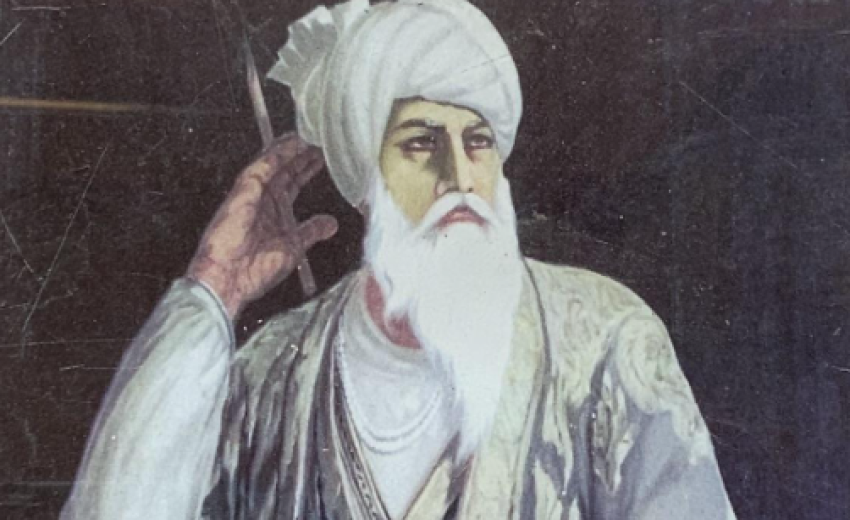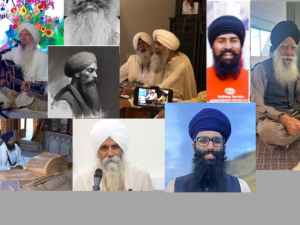Bhai Nand Lal Goya, the poet in the presence of Guru Gobind Singh, was a lover-seeker who has shown the supernatural depiction of the Guru’s pictorial words. Bhai Nand Lal was born in 1633 AD in Ghazni (Afghanistan) to Chhajju Ram Angras Khatri, a famous Persian scholar. Due to his ability, he was appointed as Mir Munshi. By 1639, Bhai Nand Lal had learned Persian and Arabic by the age of six. Possessing a sharp intellect, he became a philosopher like his father and started reciting very high quality poetry. After the death of his father Chhajju Ram in 1652 AD, he sold all his property in Ghazni and came to Multan. Bhai Sahib was called Aga (master) by his wellwisher in Ghazni, later the name of the community became "Agapuri". "Goya" title was conferred by Guru Gobind Singh and it means one who is eloquent with words.
According to Dr. Ganda Singh, "In 1652, he was appointed to the post of Munshi in the office of Nawab Wasab Khan, the ruler of Multan, by virtue of his ability and proficiency in Persian and Arabic. He was also made the fort chief and faujdar of Uttar Pradesh. But the highest post which he appointed was as the Naib Subedari of Multan ". He also received the honor of serving the Mughal princes Salim and Akbar. Bhai Nand Lal learned Gurbani and Gurmukhi from his wife. He came to Anandpur Sahib after seeing Darbar Sahib Amritsar. Bhai Sahib had great knowledge of Arabic, Persian and Mathematics . After staying at Anandpur for some time, he moved to Agra. In 1683, he became Mir Munshi of Muazzam Bahadur Shah. He was so adept at work that Bahadur Shah became obsessed with his divine qualities.
Maqsood Shah, the druga of Diwane-e-Khas, once placed a verse in the Quran in a meeting of Islamic scholars and asked for its meaning, but no one could answer accurately . The emperor was very pleased with the scholarship of a Hindu and his understanding of Islam and gave the title of 'Mulla' to Bhai Nand Lal. Secret Plans were started for Bhai Sahib to convert to Islam. Bhai Sahib had first visited Anandpur Sahib Dasam Patshah on March 29, 1682, the day of Baisakhi. Finally, Bhai Sahib, in a state of great despair, bid farewell to Prince Muazzam in 1683 CE and attended the court of Guru Gobind Singh at Anandpur Sahib. Dashmesh Pita praised his father's generosity and praised his many divine qualities, turning deep-hearted sentiments into poetry. Bhai Sahib also embodied his spiritual thoughts, devotion, Simran and priceless gems of Gurbani in his poetry. Dashmesh Pita was most appreciative of Bhai Sahib's Sikh service during the examination of the Sikh langar. When Guru Gobind Singh left Anandpur Sahib in 1705 AD, Bhai Sahib returned to his native Multan. Nothing can be said about the exact date of Bhai Sahib’s death but Dr. Ganda Singh is of the opinion that Nand Lal was present at Nanded in September 1708 AD as a revered minister of Bahadur Shah along with the royal camp. Therefore, it can be said without any doubt that he lived till 1713 CE.
Literary Works
In many Persian writings, the illuminating Personality of Guru Teghbahadur has been described in some detail and in brief.
When Bhai Nand Lal Ji reached the land of Anandpur Sahib, he presented a bouquet of 510 couplets "Bandaginama" to Guru Gobind Singh . After hearing the explanation of all the couplets in the sangat, Guru Sahib named this bouquet "Zindagi Nama" with his own hands. Ten works of Bhai Sahib have been published sofar and Bhai Sahibs compositions are recited in the Guru darbar as authentic. In Persian these are Zindagi Nama, Ghazaliyat i.e. Diwani-e -Goya, Ganjnama, Tosif-o-Sana and Khatima, Dasturul-Insha, Arzul-Alfaz.
The great personalities of Guru Tegh Bahadur mentioned in Bhai Sahib's Kalam writings are mainly Ganjnama ,Jyot Bigas and Arzul-Alfaz.
Gangnama
It is a combination of prose and poetry in which the praises of the ten Gurus are glorified. Bhai Nand Lal's devotion to the Gurus is overflowing. In these compositions, Bhai Sahib has praised Kamal Murshad with his sharp intellect, mental ability, full devotion, and the skills of an experienced society. This is in fact a unique miracle of Bhai Sahib's infinite knowledge. The total number of couplets of this composition are 160. Guru Tegh Bahadur Ji mentioned in couplets 99 to 103 (5). Before every Guru Sahib writes:
"God bless you
God be with you "
The Ninth Patshahi is the chief of the new legislators and the guardian of truth, is the Sultan of the Hereafter and the throne of honor and glory. Despite possessing divine power, he is the one who bows before God's will and is the secret instrument of divine glory and praise, the one who tests the people of holiness and the one who resurrects impartially ordained devotees. The pioneers of the great divine path and the inhabitants of the next world stand by His caste, which is dependent on Truth and is the companion of that higher power. He is especially the crown of the chosen lovers and the crown of the devotees of God who possess the virtues of truth. Related to the blessings of His Name and the adornment of abiding in Hukam and Raza.
Bhai Nand Lal writes that Guru Tegh Bahdur is a treasure of heights and praises from head to toe and is the one who enhances the splendor of the gathering of God and glory. The rays of Truth are enlightened by His pure existence which both the worlds are enlightened by His grace and blessings.
Bhai Sahib further praises Guru Tegh Bahadur and says that God has chosen him out of all the chosen virtues and has the best experience of obeying his will. He made his position immeasurable among all the accepted elders and by His grace made him a worshiper of both worlds. The hand of all is on the hem of His blessings, His true word is higher than the light of knowledge.
"Haq az hama bar-guzidgaan bar-muzidash
Taslimo Riza Ra Niko Sanjeedash. “
ਦਸਤਿ ਹਮਾ-ਗਾਂ ਬਜ਼ੈਲਿ ਅਫਜ਼ਾਲਿ
ਬਰ ਸਰੀ ਅਨਵਾਰ ਇਲਮਿ ਹੱਕ ਕਾਲੀ ਊ "
Jyot Bigas
In this work, Bhai Sahib has highlighted various aspects of Guru Nanak , the father of Sikhism, and Guru Gobind Singh . The book was first published in 1918 from Lahore. This creation has a total of 175 couplets.Guru Tegh Bahadur is mentioned only in couplet number 27. These are the only indications that (Guru) Gobind Singh Ji has appeared from the light of Guru Tegh Bahadur Ji.
“Humu Hast Tegh Bahadur Guru
Ki Gobind Singh ammad as Noor hu.”
Arzal Alfaz
It is a poem in Arabic and Persian vocabulary in which the praise of Akal Purakh and the praise of Guru Sahibs are described with a huge heart. In fact, it is a precious treasure of spiritual knowledge and philosophy. The total number of couplets in this work are 1346. The ten Gurus are mentioned in couplet number 1343. It states that he is the owner of the religion of Tikka and Jannu. He is the companion of the devotees of the ten incarnations.
He is SatGuru, Nirankaar, He is the friend and companion of the Sadh Sangat.
“Hu Al-Sadh Sangat Hu Al Yarna. "
In short, Bhai Nand Lal Goya's Kalam Poetry is an invaluable treasure of mysticism, devotion, philosophy, joy, humility, simplicity, truthfulness and spiritual wisdom which will continue to guide the universe towards the destination of patience, wisdom and compassion.





